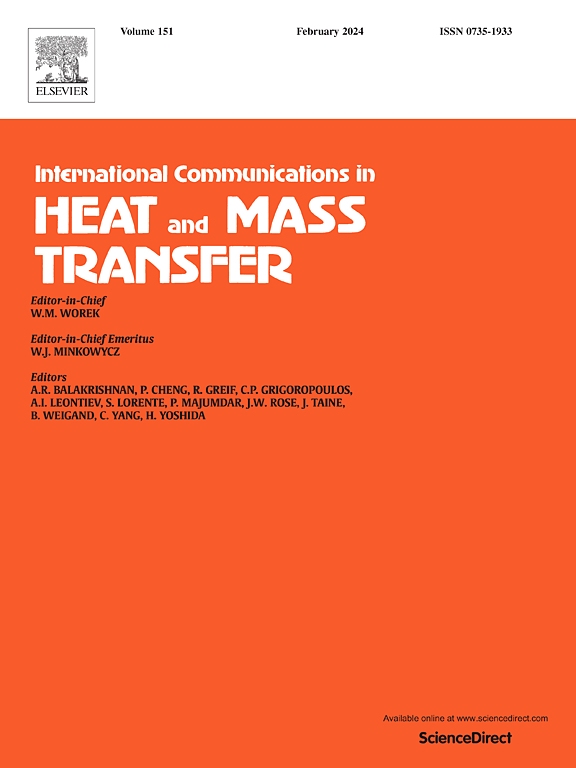Using staircase walls to improve heat and mass transfer inside a micro flat plate heat pipe cell: A molecular dynamics simulation study
IF 6.4
2区 工程技术
Q1 MECHANICS
International Communications in Heat and Mass Transfer
Pub Date : 2025-03-21
DOI:10.1016/j.icheatmasstransfer.2025.108880
引用次数: 0
Abstract
Heat pipes (HPs) dissipate heat generated or transfer heat linearly efficiently. In equipment such as electronic processors, managing the heat generated is effective in their optimal performance and survival. Micro HPs have been able to perform this task well. However, improving their thermal performance can help develop the electronics industry. In this research, staircase walls have been proposed and studied to improve a flat plate micro HP performance. Considering the dimensions of each cell (90 × 220 × 1050 Å3), the molecular dynamics (MD) method has been used for simulations. Aluminum (Al), copper (Cu), and platinum (Pt) have been used as wall metals, and ethanol (EtOH), water (H2O), and argon (Ar) as working fluids. The results show that Cu and EtOH result in the best condensation rates. The lowest and the highest condensation rates are related to Pt-H2O (62 %) and Cu-EtOH (72 %). Among all working fluids, the lowest evaporation rate is achieved using H2O. For Pt and Cu, the highest evaporation rate is obtained using EtOH (75 %). The highest evaporation rate for Al is obtained using Ar (75 %). Among all wall materials, the highest mass transfer rate improvement is related to Al (4 % for Al-Ar and 3 % for Al-H2O). In all cases, H2O results in the lowest mass transfer rate. The highest mass transfer rate experienced corresponds to Al-Ar and equals 38 %. The lowest and highest heat flux experienced are related to Pt-Ar and Cu-H2O and are 1599 and 1833 W/cm2, respectively. Cu has the highest heat flux compared to the other two metals. In all cases, the staircase walls improve the heat flux. The highest improvement is also equal to 3.1 % and is related to EtOH.
求助全文
约1分钟内获得全文
求助全文
来源期刊
CiteScore
11.00
自引率
10.00%
发文量
648
审稿时长
32 days
期刊介绍:
International Communications in Heat and Mass Transfer serves as a world forum for the rapid dissemination of new ideas, new measurement techniques, preliminary findings of ongoing investigations, discussions, and criticisms in the field of heat and mass transfer. Two types of manuscript will be considered for publication: communications (short reports of new work or discussions of work which has already been published) and summaries (abstracts of reports, theses or manuscripts which are too long for publication in full). Together with its companion publication, International Journal of Heat and Mass Transfer, with which it shares the same Board of Editors, this journal is read by research workers and engineers throughout the world.

 求助内容:
求助内容: 应助结果提醒方式:
应助结果提醒方式:


